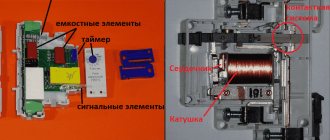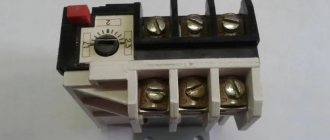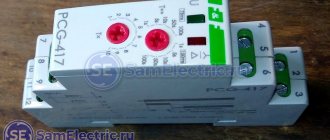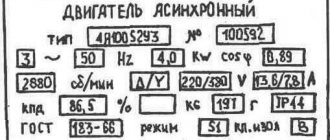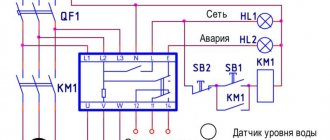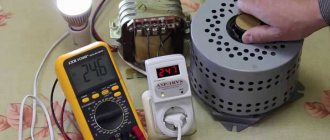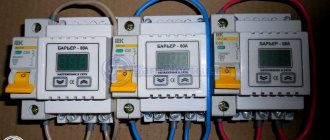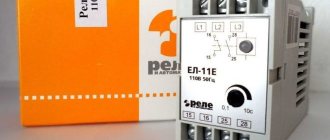In industry and everyday life, there is a constant need to monitor the levels of liquids in containers. Measuring devices are classified as contact and non-contact. For both options, the water level sensor is located at a certain height of the tank, and it is triggered, signaling or giving a command to change the mode of its supply.
Contact devices operate on the basis of floats that switch circuits when the liquid reaches specified levels.
Non-contact methods are divided into magnetic, capacitive, ultrasonic, optical and others. The devices have no moving parts. They are immersed in controlled liquid or granular media or fixed to the walls of tanks.
Vertical arrangement
A float water level sensor with a vertical rod is often used. There is a round magnet placed inside it. The rod is a hollow plastic tube with reed switches located inside.
A float with an attached magnet is always located on the surface of the liquid. Approaching the reed switch, the magnetic field triggers its contacts, which is a signal that the container is filled to a certain volume. By connecting contact pairs in series through resistors, you can constantly monitor the water level based on the total resistance of the circuit. The standard signal varies from 4 to 20 mA. The water level sensor is most often placed at the top of the tank in an area up to 3 m long.
Electrical circuits with reed switches may differ even if the mechanical part is similar in appearance. Sensors are located at one, two or more levels, giving a signal about how full the tank is. They can also be linear, transmitting a signal continuously.
You might also be interested
The most sought-after characteristic of position sensors is their large operating range. Recent trends include support for connecting to standard networks and installing position sensors instead of limit switches.
In early June 2016, the Standards Group for Embedded Technologies (SGET) released a new specification, SMARC 2.0. congatec, the European leader in module manufacturing, has presented the first models meeting this specification. The modules are equipped with new Atom, Celeron and Pentium processors from Intel, codenamed Apollo Lake.
The First Moscow State Medical University named after I.M. Sechenov uses a video surveillance system consisting of 600 IP cameras controlled by the Macroscop software package.
Horizontal arrangement
If it is not possible to install the sensor from above, it is attached horizontally to the wall of the tank. A magnet with a float is installed on a lever with a hinge, and a reed switch is placed in the housing. When the liquid rises to the upper position, the magnet approaches the contacts and the sensor is triggered, signaling that the limit position has been reached.
In case of increased contamination or freezing of the liquid, a more reliable float water level sensor on a flexible cable is used. It consists of a small sealed container located at depth with a metal ball with a reed contact or toggle switch inside. When the water level coincides with the position of the sensor, the container turns over and the contact is activated.
One of the most accurate and reliable float sensors is magnetostrictive. They contain a float with a magnet that slides along a metal rod. The principle of operation is to change the duration of passage of an ultrasonic pulse through the rod. The absence of electrical contacts significantly increases the clarity of operation when the interface reaches a given position.
What types of sensors are there?
The electrode sensor consists of three electrodes - one short and two long. The short electrode acts as a maximum level sensor, and the long ones serve as a minimum level sensor. When the liquid comes into contact with the short electrode, the pump motor turns off, signaling that the upper level has been reached. When the liquid level drops to the long electrodes, the pump turns on and the container begins to fill.
The float sensor is based on a float with a magnet installed inside it and a reed switch built into the sensor tube. When the liquid level changes, the float rises or falls, the magnet approaches the reed switch, which leads to the closure of the contact.
Capacitive sensor or, as it is commonly called, a parametric type water level meter. Such sensors are capable of transforming the measured value into a change in capacitance.
Capacitive level sensors
Depending on which sensor is installed in the water level regulator used, the circuit of the relay itself will depend.
Capacitive sensors
The non-contact device responds to the difference between the dielectric constant of different materials. The water level sensor in the tank is installed outside the side wall of the tank. In this place there should be an insert made of glass or fluoroplastic so that the interface between the media can be distinguished through it. The distance at which the sensitive element detects changes in the controlled environment is 25 mm.
The sealed design of the capacitive sensor makes it possible to place it in a controlled environment, for example, in a pipeline or in a tank lid. However, it may be under pressure. In this way, the presence of liquid in the closed reactor is maintained during the technological process.
Conductometric sensors
Conductometric level sensors (Fig. 2, 3) are used to control one or more limit levels of liquid that conducts electric current. Such liquids include solutions of acids and alkalis, water and aqueous solutions of salts, food products, etc. The operating principle of these sensors is based on the difference in electrical conductivity of liquid and air, recorded by an electrode. Conductometric sensors come in both single-rod (single-electrode) and multi-rod (multi-electrode) types for monitoring multiple liquid levels.
Rice. 2. Conductometric level sensor 3-rod OWEN DSP.3
Rice. 3. Conductometric level sensor OWEN DS.PVT
Conductometric sensors (type DU, DS and DS.PVT ) in the simplest case are insulated metal electrodes made of stainless steel. One electrode is common to the entire control circuit; it is installed in the tank so that its working part is in constant contact with the liquid (from the lower to the upper control level). When installed in a metal tank, its body can be used as a common electrode. The remaining electrodes are signal electrodes and are located at levels corresponding to their purpose. As the reservoir fills, the electrodes, in contact with the liquid, close an electrical circuit between the common and corresponding signal inputs of the device.
Electrode sensors
A water level sensor with electrodes placed in a liquid responds to changes in electrical conductivity between them. To do this, they are secured with clamps and placed at the extreme upper and lower levels. Another conductor is installed in pair with the longer one, but usually a metal tank body is used instead.
The water level sensor circuit is connected to the pump motor control system. When the tank is full, all electrodes are immersed in liquid and a control current flows between them, which is a signal to turn off the water pump motor. Water also does not flow unless it touches the exposed upper conductor. The signal to turn on the pump is a decrease in the level below the long electrode.
The problem with all sensors is the oxidation of contacts in water. To reduce its influence, use stainless steel or graphite rods.
Our range
Inexpensive sensors are suitable for analysis of clean drinking water, condensate monitoring, wastewater treatment processes, and so on. The key feature of the budget category is efficiency, while maintaining high performance characteristics.
Memosens digital non-contact water conductivity sensors provide accurate data transmission at a distance of up to 100 meters from the analyzing unit. They are equipped with durable housings and are able to operate in a wide temperature range. The range includes economical models with high performance.
Devices with increased protection are designed for use in acidic and heavily chemically contaminated environments. A special polymer housing protects the internal components; the reading element is made of high-strength alloys. An additional advantage is the wide range of temperatures and pressures. two-electrode sensors are used to control the quality of technological processes for liquid purification and water treatment.
Compact products can be easily and quickly cleaned of dirt. Four-electrode sensors are used to accurately measure electrical conductivity. Their design allows measurements in highly contaminated environments and in substances including caustic and bleaching solutions. Modern models have compact sizes, high accuracy and reliability.
Syntrol specialists are always ready to provide complete information about the products offered and help with the choice. For a free consultation, use email or phone.
DIY water level sensor
The simplicity of the device makes it possible to make it yourself. This requires a float, a lever and a valve. The entire structure is located at the top of the tank. A float with a lever is connected to a rod that moves the piston.
When the water reaches the upper limit level, the float moves a lever that acts on the piston and closes the flow through the lower pipe.
As the water flows, the float lowers, after which the piston again opens the hole through which the tank can be refilled.
With the correct selection and manufacture, a water level sensor, assembled with your own hands, works reliably in the household.
Conductometric level sensors ARIES
The OWEN company serially produces level switches of the DS and DU types, designed to monitor the levels of electrically conductive liquids.
| DS.PVT | D.S.P |
| Chipboard.3 | DU.4 | Rod with adapter |
Fig.1. Conductometric level sensors
Conductometric type level sensors (Fig.
1) are used to protect containers from overfilling, protect pumps from running dry, and control one or more levels of electrically conductive liquids (more than 0.2 S/m).
AREA AND FEATURES OF APPLICATION, REQUIREMENTS FOR WORKING FLUID
Conductometric type sensors are successfully used to measure the level of liquids with conductivity from 0.2 S/m, temperature up to +350 °C and pressure within 6.3 MPa. The exact values of the characteristics depend on the materials of the housing and insulation and must be indicated by the manufacturer.
The most common types of working fluids include:
- tap, technical and sea water;
- weak solutions of salts, alkalis and acids;
- waste and drainage water;
- food liquids (kvass, beer, milk, drinks).
The standard area of application of conductometric sensors is the measurement of liquid levels in the food, chemical and agricultural industries and energy. In particular, they are installed in automatic control systems for food and beverage production lines, water treatment and supply systems, treatment, watering and drainage facilities.
Failure-free operation at excess pressure makes their operation possible in boiler houses, pumping stations and hydraulic structures. The type of working container can be any, including open and closed commodity tanks of various shapes and volumes.
These types of sensors are not intended for monitoring the level of viscous, sticky or dielectric liquids. Excessive foaming or steaming of the working medium may also be a limitation for use (in this case they are replaced by more advanced modifications or other types of IP).
Corrosive influences pose a danger primarily to the sensitive element of the sensor, but in some cases, conductive deposits also form on its insulation.
Manufacturers solve this problem by selecting different materials; taking into account their recommendations when choosing a sensor taking into account the parameters of the working fluid is mandatory.
Ds universal conductometric level sensors
Conductometric type level sensors are designed to signal the levels of electrically conductive liquids (water, milk, food products - weakly acidic, alkaline, etc.). The principle of operation of the sensors is based on a change in electrical conductivity between the common and signal electrodes depending on the level of the signaled liquid.
Modifications of conductometric level sensors ARIES DS
Conductometric level sensors OWEN DS are available for operation at various pressures and temperatures. The DS.PVT sensor is designed for operation in saturated steam.
Modifications and main parameters of conductometric level sensors ARIES DS
| Operating pressure | 2.5 MPa | 0.25 MPa | 0.1 MPa | 2 MPa |
| Working temperature | 240 °C | 100 °C | 70 °C | |
| Number of electrodes | 1 | 3 |
Rods (electrodes) for conductometric level sensors
The rods are available in the following versions: 0.5 / 1 / 1.95 / 1.95 with adapter / 2.5 / 3 / 3.5 / 4 m.
A rod with an adapter allows you to increase the length of the electrodes. The fixed length of the rod is 1.95 m. Thanks to the adapter, you can increase the length of the sensor electrode up to 10 m. The collapsible design of the electrode ensures ease of transportation.
Electrode material – stainless steel. 12Х18Н10Т.
The rods are not included in the sensor delivery package; they must be ordered separately. When ordering a rod with an adapter, the kit includes: a 1.95 m long electrode with threads on both sides, an adapter, two nuts.
Design. Principle of operation. Application
The operating principle of a conductometric sensor is based on the difference between the electrical conductivity of air and liquid. This difference is recorded by two electrodes: a signal electrode, set at the required level, and a common electrode. When the surface of the liquid comes into contact with the signal electrode, a short circuit occurs between the two electrodes.


